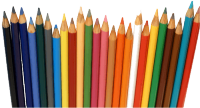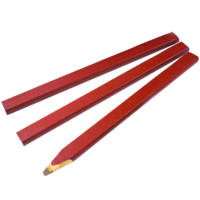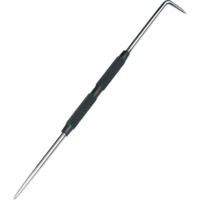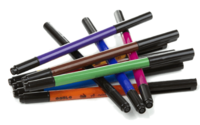Pens and Pencils
From DT Online
| Drawing Pencil | Pencil leads are graded according to their ‘hardness’ (H) and ‘blackness’ (B) by varying the mix of Clay and Graphite - a 2H pencil is useful for Technical Drawing, HB is the common writing grade and a 2B pencil is good for shading pencil sketches. The body of good quality pencils is made of Cedar and this can be indentified by the distinctive scent released when the pencil is sharpened.
Note: Always try to use a full length pencil for best control when drawing or sketching and keep it sharpened. |
|
| [https://en.wikipedia.org/wiki/Pencil Coloured Pencils (aka Pencil Crayons);; | Unlike the leads in Drawing Pencils the core of these is based on wax mixed with Pigments to provide the required colour.
Activity: Try shading in a sketch using a 2B Drawing Pencil for example (or ‘blacker’) then go over it again with light shading using a coloured pencil to create an easily achievable presentation sketch (when shading, hold the pencils well back and use light strokes in one direction only) Note: The Snowman by Raymond Briggs was illustrated using Coloured Pencils. |
|
| Carpenter's Pencil | These flat, rectangular pencils have bodies which provides a for strong grip. The strong and larger lead can withstand being used on rough surfaces and their shape enables them to be sharpened to a more durable knife edge instead of just a point. Because of their rectangular shape these pencils are usually sharpened with a knife although specialised Pencil Sharpeners are available.
Safety Point! When using a Knife always push the knife away from yourself and take small shavings at a time. Note: Using a Chisel or Plane to sharpen pencils is bad practice because it blunts the edges of the tools. |
|
| Scribers | These are made from a rod of Hardened and Tempered Tool Steel which has been ground to a fine point at one or both ends. They are used to mark accurate lines - usually when working in metal.
Scribers are sharpened to a 30 degree point by holding them Tangentially to a Tool Grinder and rotating them. This tends to create grinding marks which run along the point and strengthen it rather than weakening it by going across. Note: When scribing lines for bending or folding sheet metal (or plastics) always mark on the surface that will become the inside of the bend. In this way, Compressive Forces will close up the scribed line during bending, whereas if on the outside, Tensile Forces would open it up and may cause the material to tear or fracture. Note: To make scribed lines stand out more, bright steel can be coated with Marking Blue (or a felt tipped pen) whilst black steel or rusty metal can first be rubbed with chalk. |
|
| Felt Tipped Pens and Markers | These are available in a wide range of colours as erasable and permanent markers. Special purpose variants include: highlighter pens, security markers and pens suitable for writing on shiny surfaces such as CDs or DVDs. Designers may use high quality markers, available in the Pantone range of colours, to hand render presentation sketches and final designs (although much of this work is now done using computers). |




